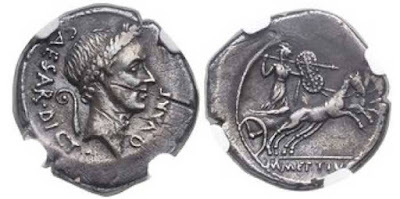During the Roman Empire, coins were defaced mostly between the 1st and the 3rd centuries AD and especially in the imperial provinces, where many cities used to strike bronze coins for local circulation.

Julius Caesar, as Dictator (49-44 BCE). AR denarius. NGC Choice XF 5/5 – 2/5, graffiti. | Ancient coins were often deliberately defaced or mutilated as an expression of contempt for the subject depicted or name inscribed. Coins mistreated in this way have an appeal to some collectors.
Gaius Julius Caesar was beloved by his troops and Rome’s common people, but he was hated by many of the elite. Lifetime portrait coins of Julius Caesar are in high demand from collectors, even a deep scratch is an acceptable defect. |
 | When the reclusive and paranoid Tiberius died at the age of 78, most Romans greeted the accession of his great-nephew Gaius joyfully. That didn't last long. Two years after Caligula's death, the Senate voted that all bronze coins bearing his image be melted down, but the chronic shortage of small change in the Roman economy meant this wasn't enforced, and some coins of Caligula survived, but rarely with his name or image intact. Gaius (Caligula). 37-41 CE. Æ Sestertius. Rome mint. Struck 37-38 CE. |
 | Nero. 54-68 CE. Æ Sestertius. Rome mint. Struck circa 66 CE. Nero is infamous for his debauchery and was deeply unpopular with the nobility and political class, which eventually led to his downfall. | |
 | Domitian and Domitia were a Roman imperial couple. Domitian was the Roman Emperor from 81 to 96 AD, and Domitia Longina was his wife. Domitian is recorded as one of Rome's worst emperors, the black sheep of his dynasty, and a cruel and ruthless autocrat. |





No comments:
Post a Comment